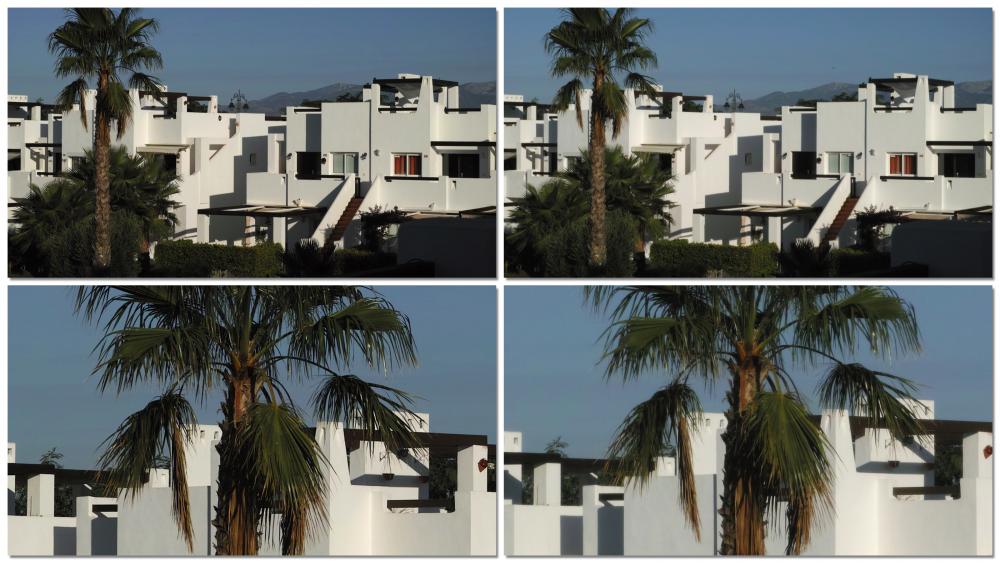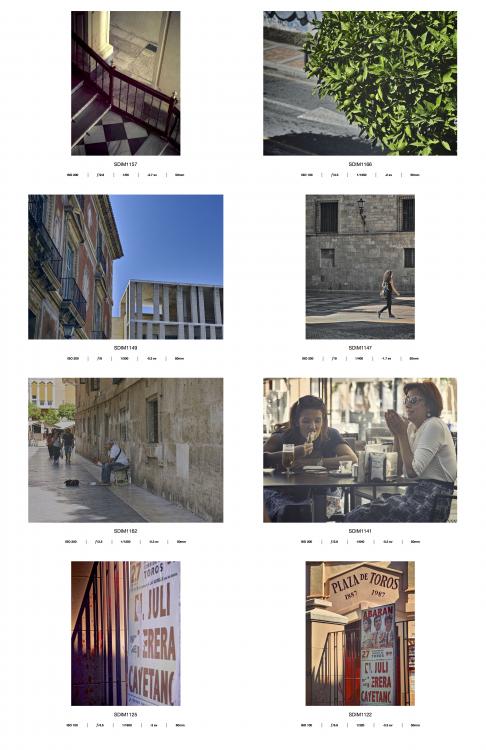Leaderboard
Popular Content
Showing content with the highest reputation on 09/19/2017 in all areas
-

Sony A7S Mark 3 - What to expect
IronFilm and 4 others reacted to Gregormannschaft for a topic
Oh come on. If you're really doing medium to high budget video projects, you are most certainly not rocking up on set with a mirrorless camera. Nor is it so easy to justify a switch between the two. The GH5 footage has the potential to be cleaner, sharper, punchier - for sure. But the difference between the two cameras is not night and day, and I'm sure a lot of clients won't be able to spot the difference. This doesn't even take into account glass, or lighting or crew size which have a much larger effect. Really, you're just perpetuating this camera myth where people like to think a new camera with flashier specs will elevate their projects, and in turn make them feel like they're a better filmmaker by owning the latest piece of gear.5 points -

Which "De-Video" filter?
AaronChicago and 2 others reacted to BTM_Pix for a topic
3 points -
A little short film I've literally just released online! Shot on a BMCC and graded with my BozBMDFilm to Rec709 LUT. Download HERE: https://bulentozdemirfilms.wordpress.com/downloads/bmcc-bmpcc-bozbmdfilm-to-rec709-lut/. Hope you like3 points
-
Panasonic GH5 - all is revealed!
Gregormannschaft and one other reacted to philipd for a topic
Yes, it is in the white paper published by the SD Association, its a new protocol and hardware specification specifically for real-time video recording, so cards of certain age could never have this addition anyway as it wasn't invented :-) It isn't just another way of advertising the speed of the card, it denotes the card supports the new video recording protocol that is optimised for video recording. The card enters a different mode of operation for video recording on cameras that also support this standard. Other cards may work absolutely fine but unlikely, the problem is cards not using the new video recording method very quickly in use get to a point they cannot sustain a fast write data-rate without pausing to do other things. This happens all the time today in the cameras, and it's fine with VBR files not going much more than 150Mbits/sec for short bursts as the cards are faster enough to catch up and buffers big enough in the cameras to ride these drops in writing performance. When you are needing to push 400Mbits/sec constantly (not VBR) no matter how fast modern cards are at the moment, any pause in accepting data gives rise to a situation that the card can't run ahead and catch up quick enough, and very quickly the camera is going to have a buffer overflow and quit recording either within seconds are randomly as you try and use it. Cards with the V moniker, like V90, enter a different operating mode that allows them to sustain the minimum data-rate required. The reason why V90 cards are not readily available (same for V60), is that it isn't just a new sticker on the same old cards, but actually something very challenging and expensive to produce, i.e. it requires the best NAND memory and fast controller hardware and good firmware on the card with a low yield rate no doubt further increasing the cost and lack of availability. We will find out soon enough who is right, I hope I'm wrong as I don't want to pay a premium and replace good memory cards if I don't need to either.. However it was Panasonic instrumental in introducing this new protocol in SD version 5.0 or higher specifically to allow cameras like the GH5 to run at very high bit-rates to SDXC memory cards, as it couldn't be done otherwise. Regards Phil2 points -
Best 4k PL cinema camera under $7k?
webrunner5 and one other reacted to mercer for a topic
In your opinion, does the GH5 give you half the quality of the Ursa? More than half? Less than?2 points -

The new forum theme
no_connection and one other reacted to Andrew Reid for a topic
Yeah I'm dialing down the insane amount of white. Why is it nobody can design things anymore... UPDATE: Getting there now... made some more tweaks and I'm starting to like things more.2 points -
Proven by who? Where is the source? And.. I'm sure bean counters in big corporations know better where profit comes from than some random Gender Studies professors. I don't believe Apple hire males because they are male! Its Apple you're talking about.. a completely liberal company.2 points
-

Wonderfully cinematic stills
Inazuma and one other reacted to Tim Sewell for a topic
One of my first 'inspired by Edo' shots, from Friday just gone:2 points -

Wonderfully cinematic stills
thefactory reacted to Tim Sewell for a topic
Check this guy out: http://www.edlondonphotography.co.uk/1 point -
@ssrdd 4K ain't worth the price (or the effort). I will stop shooting video until 8K cameras cost less than 999$.1 point
-

Which "De-Video" filter?
Jonesy Jones reacted to AaronChicago for a topic
Great example above @BTM_Pix @Jonesy Jones Maybe try 1 and 2. I prefer 2 for anything under 35mm. 1 does really well for 50mm and up. I've got a shoot today where I can do a quick A/B on a subject.1 point -
Obviously, I am no expert on his work since I first heard of him an hour ago and only looked at a couple dozen of his photos, but there is an interesting beauty to that series. It's definitely visceral but from the few photos I did see, there is a faded memory angle to it but also perhaps a distaste for rural America. Of course, I just like dem pitures.1 point
-

Free Music Resource
Kisaha reacted to Andrew Reid for a topic
Hey Eric It's amazing what you are doing. I'll make this post a sticky. Cheers!1 point -
The extent of my cultured critique of his work at that show was that I wouldn't trust him if I saw him at shop buying a shovel, plastic bags and some lime thats for sure ! I think I remember reading somewhere that he now uses a Phase One system.1 point
-

New EOSHD Pro Color 3.0 and EOSHD Pro LOG comes to Sony cameras
tomsemiterrific reacted to Andrew Reid for a topic
You don't need to do the A-B G-M adjustments when using AWB. The adjustment is for getting the warm look to indoor light, like Ambient White Balance Mode does, on cameras that lack it.1 point -
Thanks for that. Interesting read. Of course the buffer test is not the best test I can imagine but it is, nevertheless, a test. A scalable test involving video will not be possible, only a duration one for one speed. As per page 5, I would not be surprised if the Sandisk U3 cards are quite capable of sustained V60. The example they give is a C10 managing V30. On page 7 it's a bit unclear. One of those things I'd love to speak with an engineer directly about. Most of the protocol seems to not deal with the above but with rewrite issues and parallel streams (like video with interleaved gps). At this stage I am satisfied that buffer tests showing double 30MB/s (actually 70MB/s) will be more than sufficient given that 50MB/s is the maximum sustained required. As I have a sandisk UHS-II card I will obviously test this myself on the firmware in a couple of weeks. The two takeaway points seem to be if you have the option of the Sandisk UHS-II U3 and a Sandisk V90 then go for the V90. But don't sweat it. The other point would be to follow normal sd card practise and not delete individual files or in another device. Use the camera to format the whole card when space needs to be reclaimed. So if that document is the only basis for saying "If the card doesn't show V30/V60/V90 it doesn't have support for ... real-time video recording" then I think that would be incorrect and misses the point of what the standard is trying to do. The exciting thing is that in a very short time we will have 1000 testers across the world. :D1 point
-
Hi Copying files are not a true test to see if a card has a sustained data-rate suitable for high bit rate video, for example the copy may dip to almost zero bps then burst a lot higher, giving a high overall average but would break when writing real-time video that can't be halted or would see a buffer overflow. This is why they've introduced a new standard so we know the card will work at a sustained minimum. File copies are different to different to real-time streaming. Some details are in the white paper https://www.sdcard.org/downloads/pls/latest_whitepapers/Video_Speed_Class-The_new_capture_protocol_of_SD_5.0.pdf it is part of the SD 5.0 specification, from page 7 onwards it goes into more technical details, and as explained it requires a card and hardware to understand the new protocol to enable it. If the card doesn't show V30/V60/V90 it doesn't have support for SD 5.0 and real-time video recording, this of course hasn't mattered previously but does now where 400Mbps constant writing speeds are required. I bet there is no current SDXC that will work in the GH5 on 400Mbps intra recording, unless it is has V60 or V90 on the label, regardless of how much it costs or how high a speed it is advertised at. I also wouldn't be surprised if on the released firmware the camera refuses to do anything unless the card reports it is V60 or better to avoid complaints of 'it isn't working'. Regards Phil1 point
-
Crewdson's 'Cathedral Of The Pines' exhibition is currently on at The Photographer's Gallery in London and is worth a visit if you're in the area. I think @mercer would enjoy this one in particular as I'm sure its a look he'd be into making if he just had the scores of crew and lights that Crewdson uses !1 point
-
1 point
-
Kinefinity Terra 5K is "not finalized on shipping date," according to their website: http://www.kinefinity.com/shop/terra/?lang=en It is still a hypothetical camera not in release, despite promises of shipping so long ago. As for the 6K sensor, it's the same as the Kinefinity 6K and has the worst rolling shutter you have ever seen in a cinema camera. For those who want 6K resolution that debayers to proper 4K, there are only going to be two realistic choices: RED and the EVA1. I think Panasonic has done something amazing and noteworthy. It's a very ambitious camera and the Vimeo footage is truly gorgeous (despite the fact that we are not even talking about the RAW 5.7K output as of yet):1 point
-

Wee man !
Dick Sweeney reacted to Justin Bacle for a topic
I could not agree more. I think the shaky footage would actually be better than the shaky vignetting :D Why don't you just crop so that you don't see the vignette ? Looks like you have the extra resolution. Just crop so that the vignette is not visible and export in 2K/FHD Also it seems that the stretch factor is a bit off. But maybe it's just me, not sure about this one. The images are quite good, just hide that shaky vignette and you're good to go again1 point -
Hi With regard to V30, V60 and V90 cards, these specify a minimum write speed, regardless of the state of card (fragmentation, erased state etc) which is the important bit of course for real-time recording, so will be lower than the headline marketing speeds. Also it is important to note that to obtain these guaranteed minimum speeds these cards need to be written to using a different protocol, and the card itself needs to specifically support this protocol as well as the camera (of course the GH5 does). This means buying a card that doesn't show the V rating, because it appears fast enough based on it's other speed ratings or some website bench-marking, is not the best route to take and will likely see problems. Regards Phil1 point
-
Panasonic GH5 Review and exclusive first look at Version 2.0 firmware
webrunner5 reacted to philipd for a topic
Hi Same here, but there is a problem with maintaining quality with 60P. All-Intra is essentially compressing each frame as a JPEG. At 400Mbits/sec and 60 images a second to create Jpegs from, that is 400/60/8 = 830KB approx for each image. Take any image at 3840x2160 pixels and save it as a Jpeg compressed down to 830KB and quality is going to suffer, and that's ignoring the fact these would be 10bit images, which being squeezed into 830KB just isn't enough space to give a benefit, and would likely look worse than the standard IBP at a lower bit rate. When looking at 24fps each frame can be around 2MB in size, considerably better. So the higher the frame-rate, the more quality sees a drop in All-Intra unless the bit rate is raised. To get the same quality in 60fps All-Intra as seen in 24fps would need a bit rate of around 960Mbits/sec. 60fps compresses quite nicely and efficiently as IBP as it is a higher sample rate than 24fps, and IBP (if the processor can keep up) compresses better the more samples it has per second. So apart from easier editing, quality is going to better than trying to compress 60fps with only 400Mbits/sec available. Regards Phil1 point -
Wee man !
Dick Sweeney reacted to tweak for a topic
Vignette is ok, but if it's moving around like that it looks horrid imo. Better to use a longer taking lens if you want to stabilise. Where are these shots taken? Looks like south coast AUS.1 point -
1 point
-
Wonderfully cinematic stills
Tim Sewell reacted to Jacek for a topic
Direct link to more of his work: https://500px.com/edlondonphotographylondon1 point -
Wonderfully cinematic stills
Tim Sewell reacted to Axel for a topic
Dramatic, expressionistic lighting, absolute depth of field, almost black & white. Our physiologic night vision (scotopic vision) shares some of these characteristics, but not all. Although our irises are wide open, we won't see things out of focus, because the rod cells are not concentrated in the fovea but instead spread over the whole retina (like here). But we would see light sources in full color, it's like "Lum Vs Sat" in Resolve. Nice, I prefer this over he modern "Night for Day" - approach that modern sensors and their lowlight-capabilities provide. Thanks for sharing.1 point -

Which "De-Video" filter?
Jonesy Jones reacted to BTM_Pix for a topic
Sorry, I just meant as a way of appraising all of the filter effects and combinations before having to buy the physical versions Found the link to the software in the shop if anyone is interested in buying it online (they must have taken them off display) https://www.cameraworld.co.uk/tiffen-dfx-v3.html1 point -
hardware for fluid premiere playback
Daniel Galli reacted to Kisaha for a topic
Cuda cores, raw processing power and RAM. Pascal GPUs are the standard right now, and for many good reasons (less power consumption= less heat = more durability = less money for cooling options = less noise etc). You also need a more recent CPU that does H265 decoding internally. I would say a 6700 or a 7700(better) with a 1060 GPU (value for money right now, no need for anything less). I do not know about AMD cpus. For financial reasons I went for 6700 and 1060 recently (for an editing laptop). For 600€ more I would have gone for 7700 and 1070 gpu (that is the combo that I consider as best value for money/perforMande right now), but as I upgrade/renew a lot of my equipment and office space, those extra hundreds were needed elsewhere.1 point -

Nikon PR nightmares
IronFilm reacted to Andrew Reid for a topic
On most forums and mainstream sites, you aren't even allowed to discuss issues of sex, race and politics so you're lucky I'm chilled out about it. If things get divisive and out of hand, only then will I stop it.1 point -

Game of Egos
jcs reacted to EthanAlexander for a topic
You're presupposing that an inability to know what world we "live" in, and a willingness to question it, means that he will conduct himself with any less meaning than you. Take for example a Catholic and an Athiest: a worshipping catholic will likely view this life as a time to honor God through every action, a time to follow God's plan. This gives that person immense meaning and a calling to do good. On the other hand, many Athiests, seeing this time on earth as our only time, with no afterlife or greater power, will choose to make the most of every second still breathing. This includes treating others with respect because this is their only time, too. Two opposite ends of the spectrum, same result in action. So, why can't someone question this reality without being labeled ignorant? If people never questioned anything, we'd be no different than chimpanzees.1 point -

Good cinematic examples using Sony A7S/A7R
Phil A reacted to Tim Sewell for a topic
The guy joins the forum, looking for pointers to clips that in the forums' users' opinions are cinematic-looking and he gets greeted like that by one of the moderators. Wow - I bet he'll be recommending EOSHD to his pals as a real friendly and helpful place.1 point -

Canon 5D Mark III - 3.5K and 4K raw video with Magic Lantern
maxotics reacted to Drew Allegre for a topic
1 point -
Petition for Samsung NX1 hack
Werner H. Graf reacted to Kisaha for a topic
NX1's AF was the second best back then, not that further away from Canon's, and still I prefer it from Sony's for video (so in my opinion, it is still the second best!). Samsung was nothing to Canon back then, the smaller players were afraid the most (Olympus, Fuji, Panasonic mainly; Sony was worried, and Nikon would have been doomed). Olympus and Fuji haven't the resources to fight Samsung, Nikon can't compete in the new digital age, and even Panasonic is much smaller than Samsung. Sony is powerful, but Samsung had some amazing R&D breakthroughs, and the capacity to manufacture EVERYTHING you need for a photo/video camera (CPUs, RAMs, lenses, Super AMOLED touch screens, everything). First 28mpxls BSI sensor (A7Rii was the second big sensored BSI actually) etc etc. Samsung just decided that they didn't want to compete on a declining market, and pro video/photography was a long shot. NX1 was too late in the game. It is just a pity that we didn't see a NX1mkII, they did the first version SOOOOO good, without any prior real practical experience. The NX team had some truly talented and passionate people (just check some of their older corporate videos), something that a huge capitalistic and autocratic mega-trust, couldn't allow to exist.1 point -
So now that you can "react" instead of just "like".. does a "confused" reaction, for example, still contribute to the reputation points of the member who made the post? Just curious; seems like it probably shouldn't work that way.0 points





.thumb.jpg.db5fdf4cc2b5e408fbefc922238d9210.jpg)





